UGB165 - Toyota's Risk Management Strategy and Operations Post-Shock
VerifiedAdded on 2023/06/17
|12
|3696
|498
Report
AI Summary
This report examines Toyota's risk management strategies in light of recent disruptions, such as natural disasters that led to production suspensions and recalls. It evaluates risk avoidance, transfer, acceptance, and reduction strategies, recommending risk reduction as the most suitable approach for Toyota. Furthermore, the report details a company-wide operations improvement strategy, emphasizing the Six Sigma methodology to enhance operational efficiency and build resilience against unpredictable events. The goal is to guide Toyota in improving its global business operations, consumer experience, and profitability amid future challenges. Desklib offers more solved assignments and past papers for students.
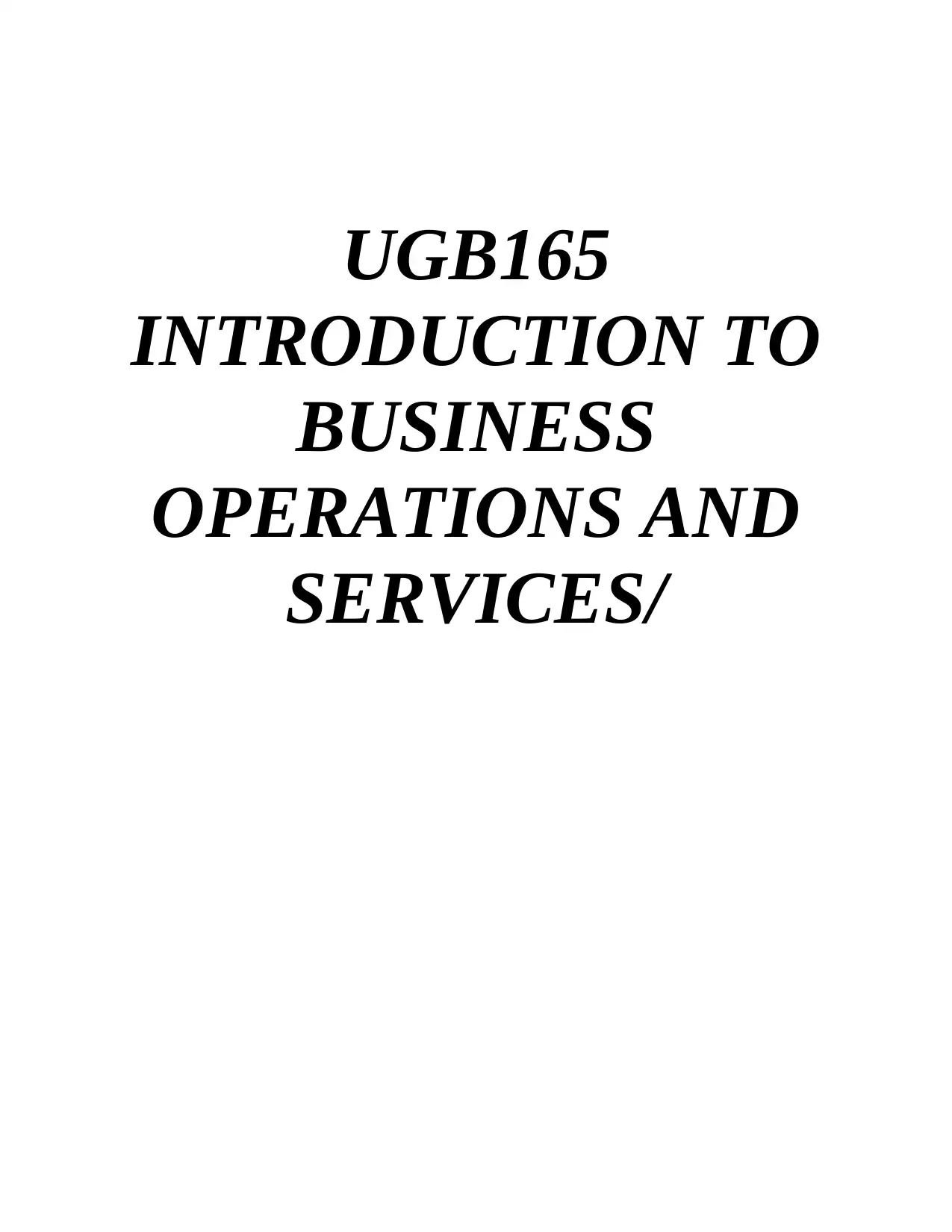
UGB165
INTRODUCTION TO
BUSINESS
OPERATIONS AND
SERVICES/
INTRODUCTION TO
BUSINESS
OPERATIONS AND
SERVICES/
Paraphrase This Document
Need a fresh take? Get an instant paraphrase of this document with our AI Paraphraser
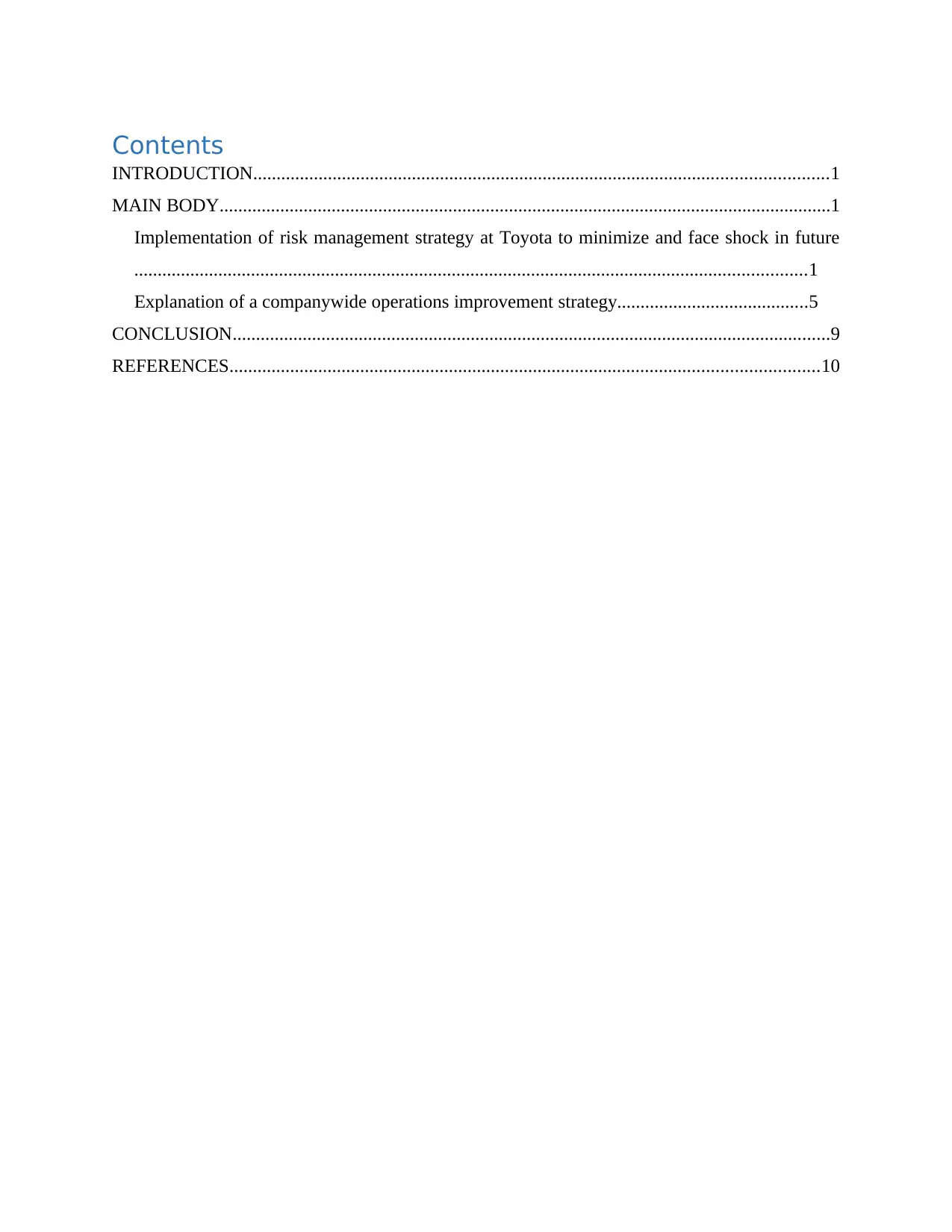
Contents
INTRODUCTION...........................................................................................................................1
MAIN BODY...................................................................................................................................1
Implementation of risk management strategy at Toyota to minimize and face shock in future
................................................................................................................................................1
Explanation of a companywide operations improvement strategy.........................................5
CONCLUSION................................................................................................................................9
REFERENCES..............................................................................................................................10
INTRODUCTION...........................................................................................................................1
MAIN BODY...................................................................................................................................1
Implementation of risk management strategy at Toyota to minimize and face shock in future
................................................................................................................................................1
Explanation of a companywide operations improvement strategy.........................................5
CONCLUSION................................................................................................................................9
REFERENCES..............................................................................................................................10
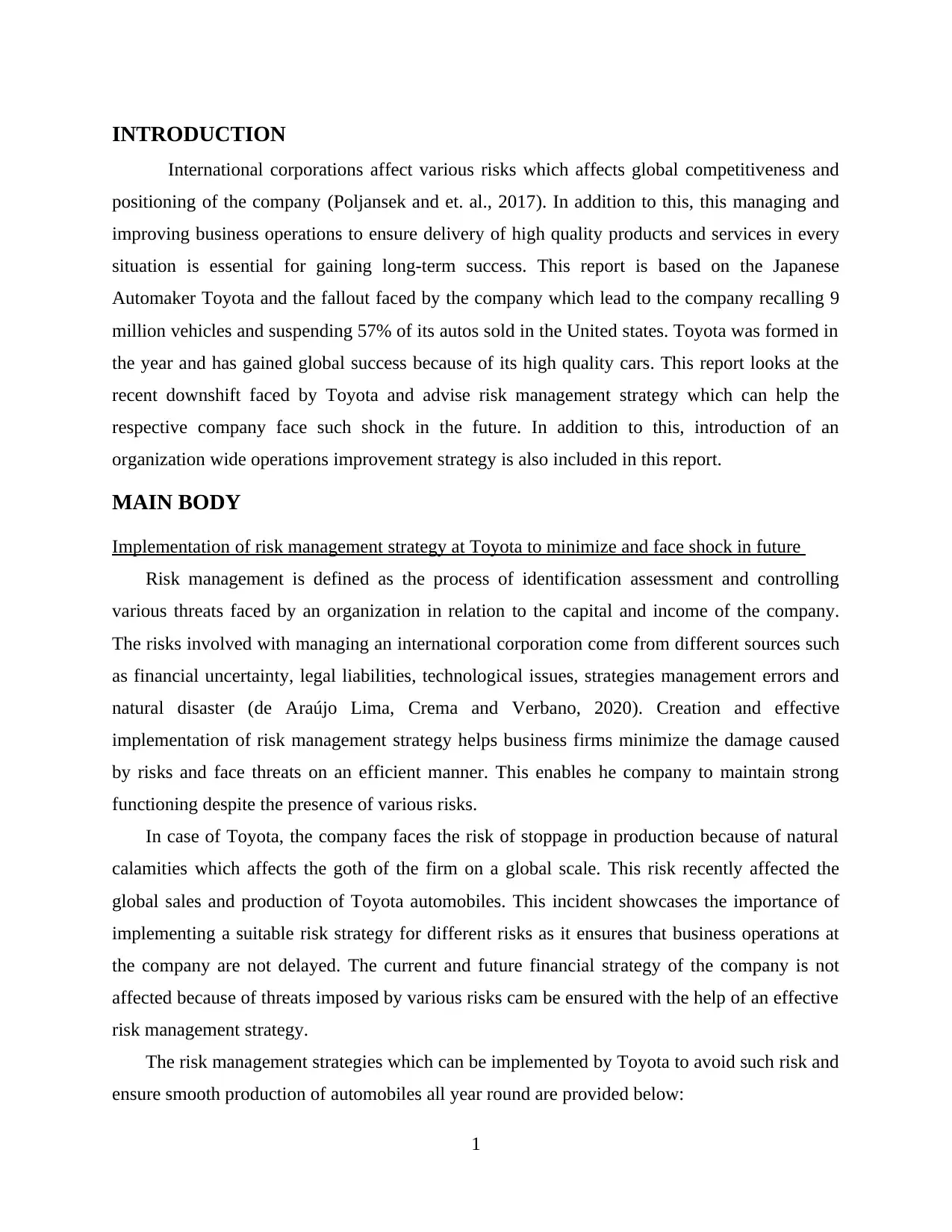
INTRODUCTION
International corporations affect various risks which affects global competitiveness and
positioning of the company (Poljansek and et. al., 2017). In addition to this, this managing and
improving business operations to ensure delivery of high quality products and services in every
situation is essential for gaining long-term success. This report is based on the Japanese
Automaker Toyota and the fallout faced by the company which lead to the company recalling 9
million vehicles and suspending 57% of its autos sold in the United states. Toyota was formed in
the year and has gained global success because of its high quality cars. This report looks at the
recent downshift faced by Toyota and advise risk management strategy which can help the
respective company face such shock in the future. In addition to this, introduction of an
organization wide operations improvement strategy is also included in this report.
MAIN BODY
Implementation of risk management strategy at Toyota to minimize and face shock in future
Risk management is defined as the process of identification assessment and controlling
various threats faced by an organization in relation to the capital and income of the company.
The risks involved with managing an international corporation come from different sources such
as financial uncertainty, legal liabilities, technological issues, strategies management errors and
natural disaster (de Araújo Lima, Crema and Verbano, 2020). Creation and effective
implementation of risk management strategy helps business firms minimize the damage caused
by risks and face threats on an efficient manner. This enables he company to maintain strong
functioning despite the presence of various risks.
In case of Toyota, the company faces the risk of stoppage in production because of natural
calamities which affects the goth of the firm on a global scale. This risk recently affected the
global sales and production of Toyota automobiles. This incident showcases the importance of
implementing a suitable risk strategy for different risks as it ensures that business operations at
the company are not delayed. The current and future financial strategy of the company is not
affected because of threats imposed by various risks cam be ensured with the help of an effective
risk management strategy.
The risk management strategies which can be implemented by Toyota to avoid such risk and
ensure smooth production of automobiles all year round are provided below:
1
International corporations affect various risks which affects global competitiveness and
positioning of the company (Poljansek and et. al., 2017). In addition to this, this managing and
improving business operations to ensure delivery of high quality products and services in every
situation is essential for gaining long-term success. This report is based on the Japanese
Automaker Toyota and the fallout faced by the company which lead to the company recalling 9
million vehicles and suspending 57% of its autos sold in the United states. Toyota was formed in
the year and has gained global success because of its high quality cars. This report looks at the
recent downshift faced by Toyota and advise risk management strategy which can help the
respective company face such shock in the future. In addition to this, introduction of an
organization wide operations improvement strategy is also included in this report.
MAIN BODY
Implementation of risk management strategy at Toyota to minimize and face shock in future
Risk management is defined as the process of identification assessment and controlling
various threats faced by an organization in relation to the capital and income of the company.
The risks involved with managing an international corporation come from different sources such
as financial uncertainty, legal liabilities, technological issues, strategies management errors and
natural disaster (de Araújo Lima, Crema and Verbano, 2020). Creation and effective
implementation of risk management strategy helps business firms minimize the damage caused
by risks and face threats on an efficient manner. This enables he company to maintain strong
functioning despite the presence of various risks.
In case of Toyota, the company faces the risk of stoppage in production because of natural
calamities which affects the goth of the firm on a global scale. This risk recently affected the
global sales and production of Toyota automobiles. This incident showcases the importance of
implementing a suitable risk strategy for different risks as it ensures that business operations at
the company are not delayed. The current and future financial strategy of the company is not
affected because of threats imposed by various risks cam be ensured with the help of an effective
risk management strategy.
The risk management strategies which can be implemented by Toyota to avoid such risk and
ensure smooth production of automobiles all year round are provided below:
1
⊘ This is a preview!⊘
Do you want full access?
Subscribe today to unlock all pages.

Trusted by 1+ million students worldwide
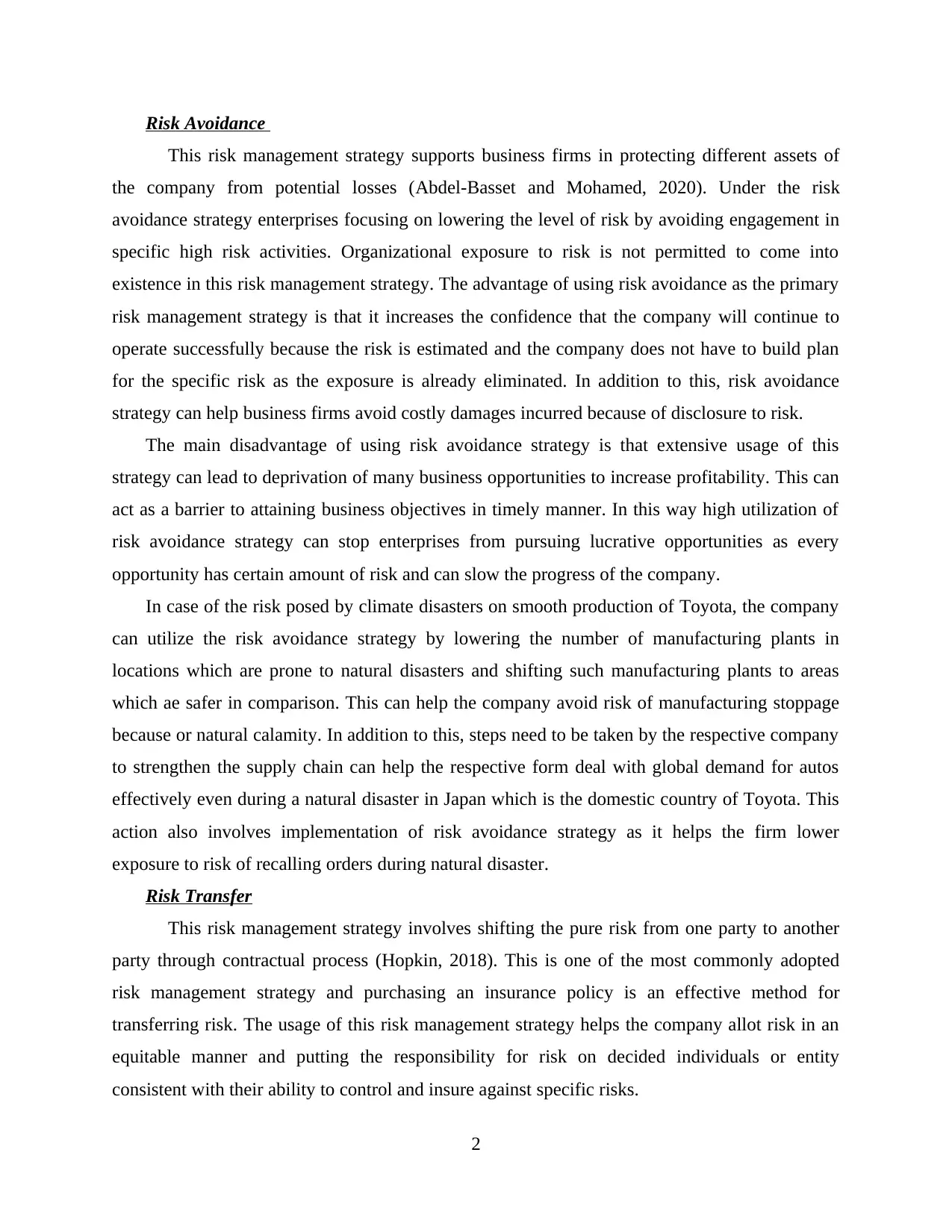
Risk Avoidance
This risk management strategy supports business firms in protecting different assets of
the company from potential losses (Abdel-Basset and Mohamed, 2020). Under the risk
avoidance strategy enterprises focusing on lowering the level of risk by avoiding engagement in
specific high risk activities. Organizational exposure to risk is not permitted to come into
existence in this risk management strategy. The advantage of using risk avoidance as the primary
risk management strategy is that it increases the confidence that the company will continue to
operate successfully because the risk is estimated and the company does not have to build plan
for the specific risk as the exposure is already eliminated. In addition to this, risk avoidance
strategy can help business firms avoid costly damages incurred because of disclosure to risk.
The main disadvantage of using risk avoidance strategy is that extensive usage of this
strategy can lead to deprivation of many business opportunities to increase profitability. This can
act as a barrier to attaining business objectives in timely manner. In this way high utilization of
risk avoidance strategy can stop enterprises from pursuing lucrative opportunities as every
opportunity has certain amount of risk and can slow the progress of the company.
In case of the risk posed by climate disasters on smooth production of Toyota, the company
can utilize the risk avoidance strategy by lowering the number of manufacturing plants in
locations which are prone to natural disasters and shifting such manufacturing plants to areas
which ae safer in comparison. This can help the company avoid risk of manufacturing stoppage
because or natural calamity. In addition to this, steps need to be taken by the respective company
to strengthen the supply chain can help the respective form deal with global demand for autos
effectively even during a natural disaster in Japan which is the domestic country of Toyota. This
action also involves implementation of risk avoidance strategy as it helps the firm lower
exposure to risk of recalling orders during natural disaster.
Risk Transfer
This risk management strategy involves shifting the pure risk from one party to another
party through contractual process (Hopkin, 2018). This is one of the most commonly adopted
risk management strategy and purchasing an insurance policy is an effective method for
transferring risk. The usage of this risk management strategy helps the company allot risk in an
equitable manner and putting the responsibility for risk on decided individuals or entity
consistent with their ability to control and insure against specific risks.
2
This risk management strategy supports business firms in protecting different assets of
the company from potential losses (Abdel-Basset and Mohamed, 2020). Under the risk
avoidance strategy enterprises focusing on lowering the level of risk by avoiding engagement in
specific high risk activities. Organizational exposure to risk is not permitted to come into
existence in this risk management strategy. The advantage of using risk avoidance as the primary
risk management strategy is that it increases the confidence that the company will continue to
operate successfully because the risk is estimated and the company does not have to build plan
for the specific risk as the exposure is already eliminated. In addition to this, risk avoidance
strategy can help business firms avoid costly damages incurred because of disclosure to risk.
The main disadvantage of using risk avoidance strategy is that extensive usage of this
strategy can lead to deprivation of many business opportunities to increase profitability. This can
act as a barrier to attaining business objectives in timely manner. In this way high utilization of
risk avoidance strategy can stop enterprises from pursuing lucrative opportunities as every
opportunity has certain amount of risk and can slow the progress of the company.
In case of the risk posed by climate disasters on smooth production of Toyota, the company
can utilize the risk avoidance strategy by lowering the number of manufacturing plants in
locations which are prone to natural disasters and shifting such manufacturing plants to areas
which ae safer in comparison. This can help the company avoid risk of manufacturing stoppage
because or natural calamity. In addition to this, steps need to be taken by the respective company
to strengthen the supply chain can help the respective form deal with global demand for autos
effectively even during a natural disaster in Japan which is the domestic country of Toyota. This
action also involves implementation of risk avoidance strategy as it helps the firm lower
exposure to risk of recalling orders during natural disaster.
Risk Transfer
This risk management strategy involves shifting the pure risk from one party to another
party through contractual process (Hopkin, 2018). This is one of the most commonly adopted
risk management strategy and purchasing an insurance policy is an effective method for
transferring risk. The usage of this risk management strategy helps the company allot risk in an
equitable manner and putting the responsibility for risk on decided individuals or entity
consistent with their ability to control and insure against specific risks.
2
Paraphrase This Document
Need a fresh take? Get an instant paraphrase of this document with our AI Paraphraser
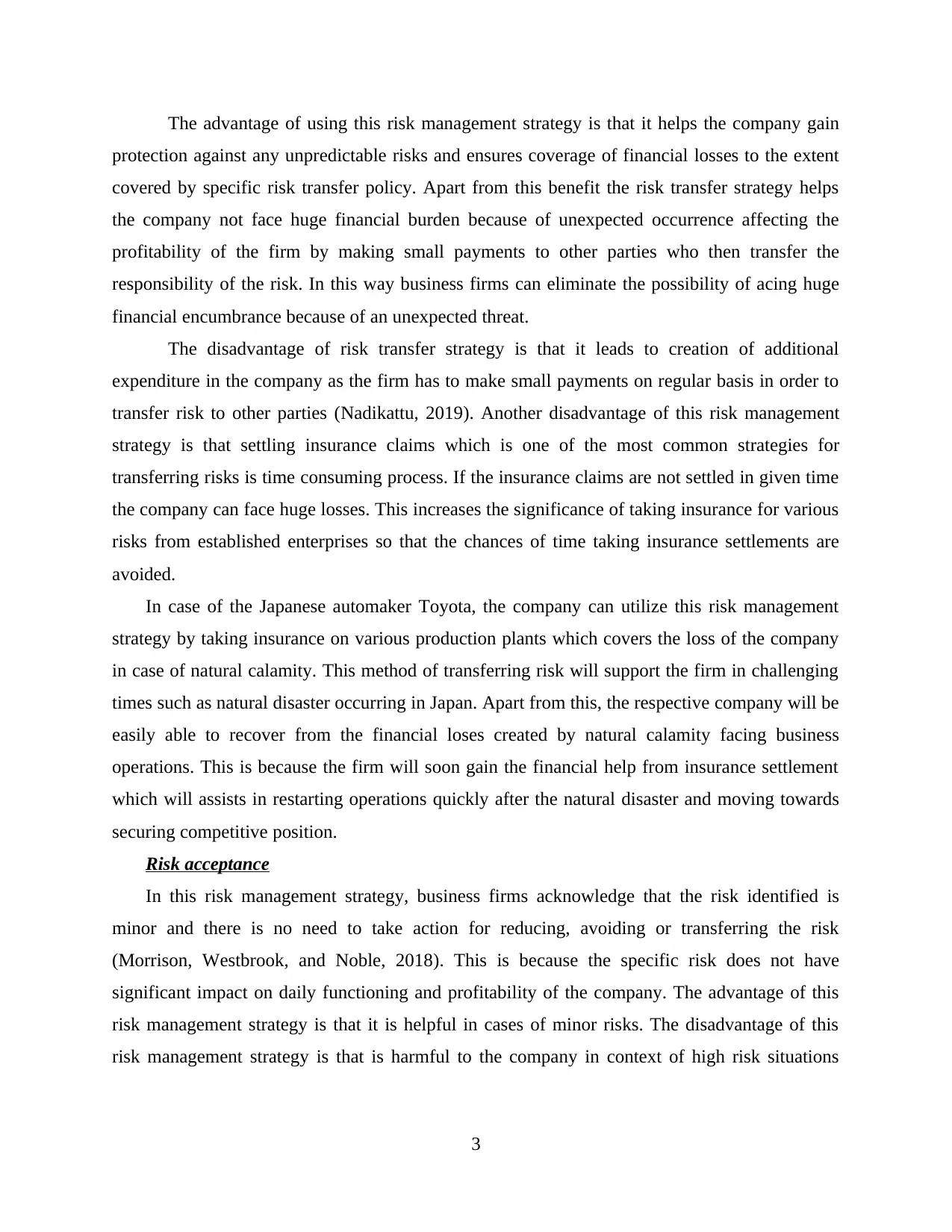
The advantage of using this risk management strategy is that it helps the company gain
protection against any unpredictable risks and ensures coverage of financial losses to the extent
covered by specific risk transfer policy. Apart from this benefit the risk transfer strategy helps
the company not face huge financial burden because of unexpected occurrence affecting the
profitability of the firm by making small payments to other parties who then transfer the
responsibility of the risk. In this way business firms can eliminate the possibility of acing huge
financial encumbrance because of an unexpected threat.
The disadvantage of risk transfer strategy is that it leads to creation of additional
expenditure in the company as the firm has to make small payments on regular basis in order to
transfer risk to other parties (Nadikattu, 2019). Another disadvantage of this risk management
strategy is that settling insurance claims which is one of the most common strategies for
transferring risks is time consuming process. If the insurance claims are not settled in given time
the company can face huge losses. This increases the significance of taking insurance for various
risks from established enterprises so that the chances of time taking insurance settlements are
avoided.
In case of the Japanese automaker Toyota, the company can utilize this risk management
strategy by taking insurance on various production plants which covers the loss of the company
in case of natural calamity. This method of transferring risk will support the firm in challenging
times such as natural disaster occurring in Japan. Apart from this, the respective company will be
easily able to recover from the financial loses created by natural calamity facing business
operations. This is because the firm will soon gain the financial help from insurance settlement
which will assists in restarting operations quickly after the natural disaster and moving towards
securing competitive position.
Risk acceptance
In this risk management strategy, business firms acknowledge that the risk identified is
minor and there is no need to take action for reducing, avoiding or transferring the risk
(Morrison, Westbrook, and Noble, 2018). This is because the specific risk does not have
significant impact on daily functioning and profitability of the company. The advantage of this
risk management strategy is that it is helpful in cases of minor risks. The disadvantage of this
risk management strategy is that is harmful to the company in context of high risk situations
3
protection against any unpredictable risks and ensures coverage of financial losses to the extent
covered by specific risk transfer policy. Apart from this benefit the risk transfer strategy helps
the company not face huge financial burden because of unexpected occurrence affecting the
profitability of the firm by making small payments to other parties who then transfer the
responsibility of the risk. In this way business firms can eliminate the possibility of acing huge
financial encumbrance because of an unexpected threat.
The disadvantage of risk transfer strategy is that it leads to creation of additional
expenditure in the company as the firm has to make small payments on regular basis in order to
transfer risk to other parties (Nadikattu, 2019). Another disadvantage of this risk management
strategy is that settling insurance claims which is one of the most common strategies for
transferring risks is time consuming process. If the insurance claims are not settled in given time
the company can face huge losses. This increases the significance of taking insurance for various
risks from established enterprises so that the chances of time taking insurance settlements are
avoided.
In case of the Japanese automaker Toyota, the company can utilize this risk management
strategy by taking insurance on various production plants which covers the loss of the company
in case of natural calamity. This method of transferring risk will support the firm in challenging
times such as natural disaster occurring in Japan. Apart from this, the respective company will be
easily able to recover from the financial loses created by natural calamity facing business
operations. This is because the firm will soon gain the financial help from insurance settlement
which will assists in restarting operations quickly after the natural disaster and moving towards
securing competitive position.
Risk acceptance
In this risk management strategy, business firms acknowledge that the risk identified is
minor and there is no need to take action for reducing, avoiding or transferring the risk
(Morrison, Westbrook, and Noble, 2018). This is because the specific risk does not have
significant impact on daily functioning and profitability of the company. The advantage of this
risk management strategy is that it is helpful in cases of minor risks. The disadvantage of this
risk management strategy is that is harmful to the company in context of high risk situations
3
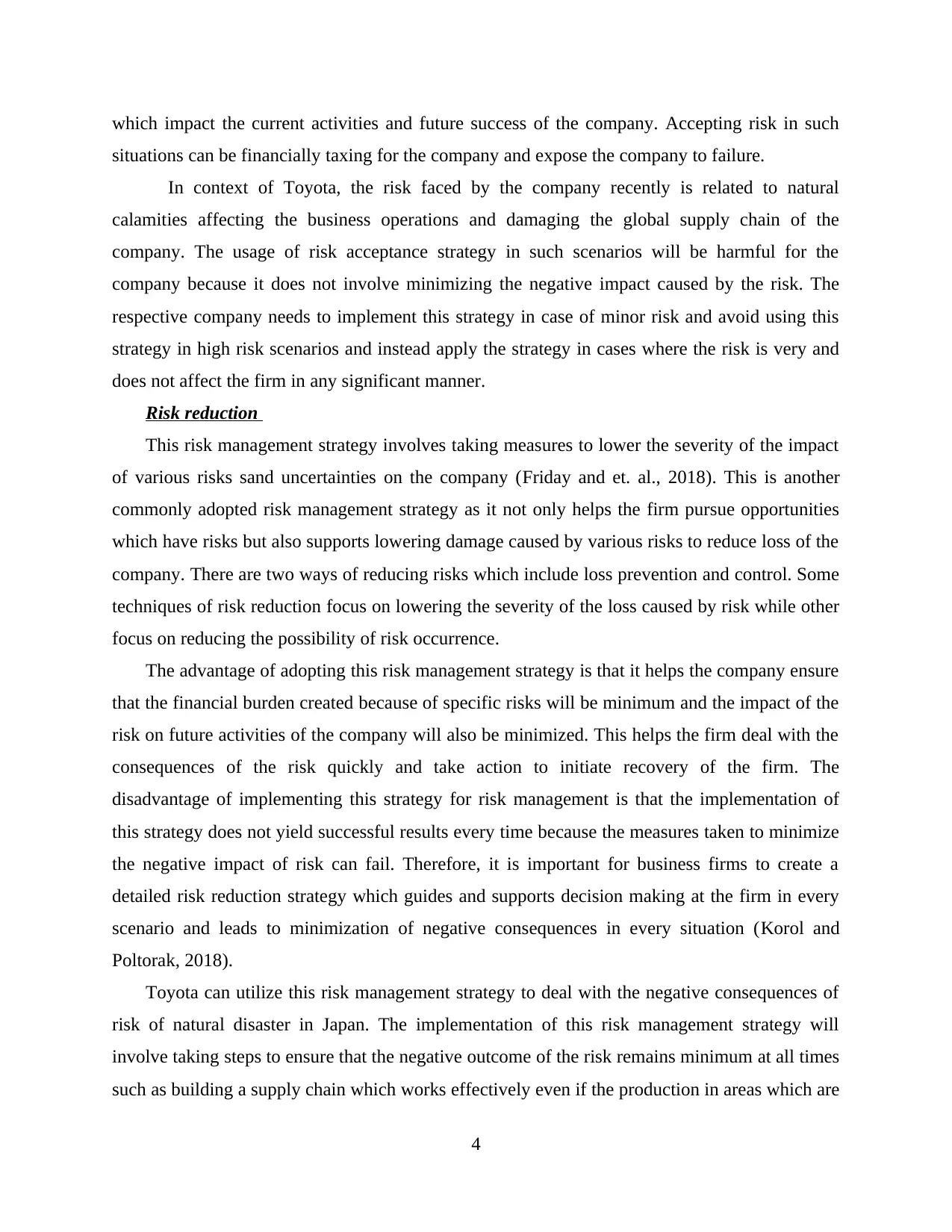
which impact the current activities and future success of the company. Accepting risk in such
situations can be financially taxing for the company and expose the company to failure.
In context of Toyota, the risk faced by the company recently is related to natural
calamities affecting the business operations and damaging the global supply chain of the
company. The usage of risk acceptance strategy in such scenarios will be harmful for the
company because it does not involve minimizing the negative impact caused by the risk. The
respective company needs to implement this strategy in case of minor risk and avoid using this
strategy in high risk scenarios and instead apply the strategy in cases where the risk is very and
does not affect the firm in any significant manner.
Risk reduction
This risk management strategy involves taking measures to lower the severity of the impact
of various risks sand uncertainties on the company (Friday and et. al., 2018). This is another
commonly adopted risk management strategy as it not only helps the firm pursue opportunities
which have risks but also supports lowering damage caused by various risks to reduce loss of the
company. There are two ways of reducing risks which include loss prevention and control. Some
techniques of risk reduction focus on lowering the severity of the loss caused by risk while other
focus on reducing the possibility of risk occurrence.
The advantage of adopting this risk management strategy is that it helps the company ensure
that the financial burden created because of specific risks will be minimum and the impact of the
risk on future activities of the company will also be minimized. This helps the firm deal with the
consequences of the risk quickly and take action to initiate recovery of the firm. The
disadvantage of implementing this strategy for risk management is that the implementation of
this strategy does not yield successful results every time because the measures taken to minimize
the negative impact of risk can fail. Therefore, it is important for business firms to create a
detailed risk reduction strategy which guides and supports decision making at the firm in every
scenario and leads to minimization of negative consequences in every situation (Korol and
Poltorak, 2018).
Toyota can utilize this risk management strategy to deal with the negative consequences of
risk of natural disaster in Japan. The implementation of this risk management strategy will
involve taking steps to ensure that the negative outcome of the risk remains minimum at all times
such as building a supply chain which works effectively even if the production in areas which are
4
situations can be financially taxing for the company and expose the company to failure.
In context of Toyota, the risk faced by the company recently is related to natural
calamities affecting the business operations and damaging the global supply chain of the
company. The usage of risk acceptance strategy in such scenarios will be harmful for the
company because it does not involve minimizing the negative impact caused by the risk. The
respective company needs to implement this strategy in case of minor risk and avoid using this
strategy in high risk scenarios and instead apply the strategy in cases where the risk is very and
does not affect the firm in any significant manner.
Risk reduction
This risk management strategy involves taking measures to lower the severity of the impact
of various risks sand uncertainties on the company (Friday and et. al., 2018). This is another
commonly adopted risk management strategy as it not only helps the firm pursue opportunities
which have risks but also supports lowering damage caused by various risks to reduce loss of the
company. There are two ways of reducing risks which include loss prevention and control. Some
techniques of risk reduction focus on lowering the severity of the loss caused by risk while other
focus on reducing the possibility of risk occurrence.
The advantage of adopting this risk management strategy is that it helps the company ensure
that the financial burden created because of specific risks will be minimum and the impact of the
risk on future activities of the company will also be minimized. This helps the firm deal with the
consequences of the risk quickly and take action to initiate recovery of the firm. The
disadvantage of implementing this strategy for risk management is that the implementation of
this strategy does not yield successful results every time because the measures taken to minimize
the negative impact of risk can fail. Therefore, it is important for business firms to create a
detailed risk reduction strategy which guides and supports decision making at the firm in every
scenario and leads to minimization of negative consequences in every situation (Korol and
Poltorak, 2018).
Toyota can utilize this risk management strategy to deal with the negative consequences of
risk of natural disaster in Japan. The implementation of this risk management strategy will
involve taking steps to ensure that the negative outcome of the risk remains minimum at all times
such as building a supply chain which works effectively even if the production in areas which are
4
⊘ This is a preview!⊘
Do you want full access?
Subscribe today to unlock all pages.

Trusted by 1+ million students worldwide
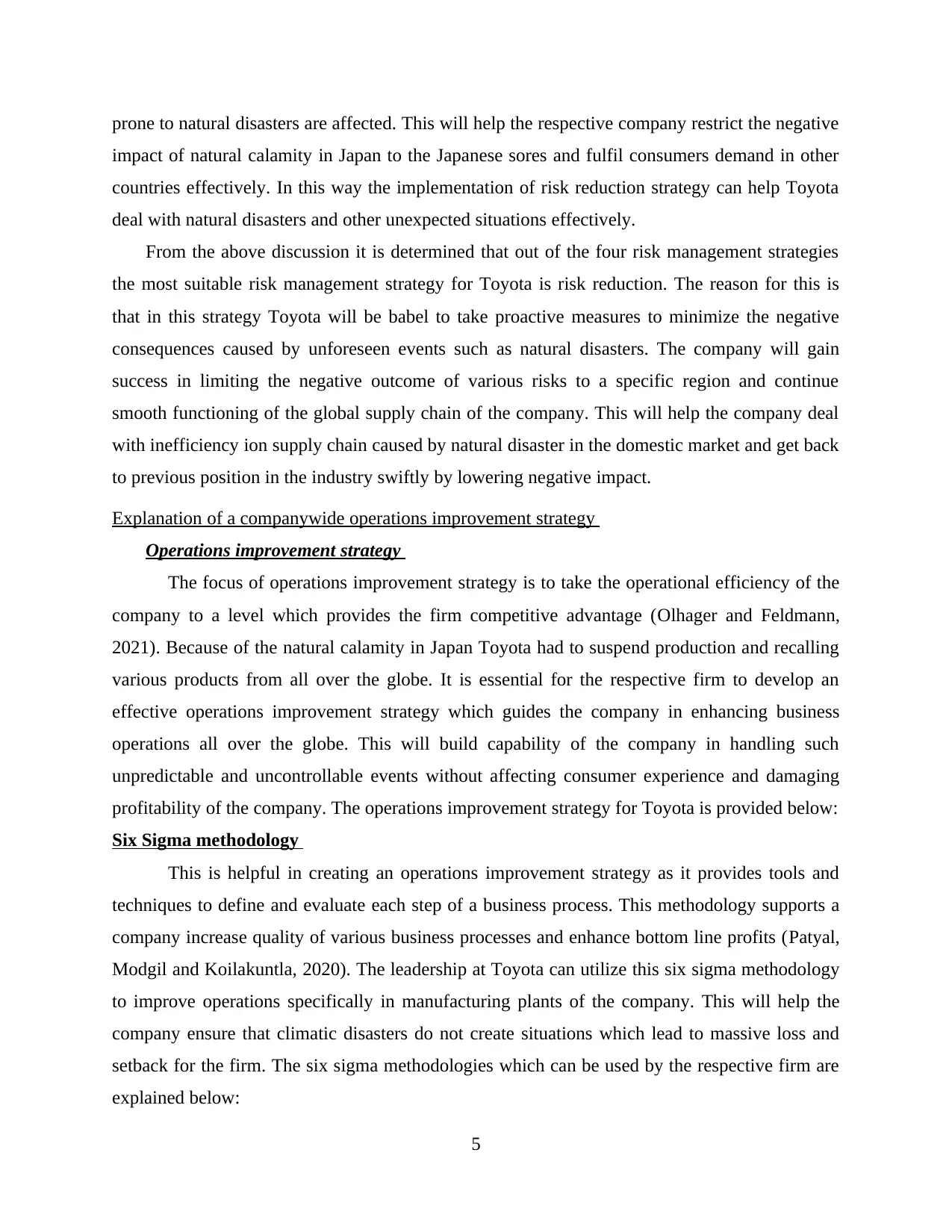
prone to natural disasters are affected. This will help the respective company restrict the negative
impact of natural calamity in Japan to the Japanese sores and fulfil consumers demand in other
countries effectively. In this way the implementation of risk reduction strategy can help Toyota
deal with natural disasters and other unexpected situations effectively.
From the above discussion it is determined that out of the four risk management strategies
the most suitable risk management strategy for Toyota is risk reduction. The reason for this is
that in this strategy Toyota will be babel to take proactive measures to minimize the negative
consequences caused by unforeseen events such as natural disasters. The company will gain
success in limiting the negative outcome of various risks to a specific region and continue
smooth functioning of the global supply chain of the company. This will help the company deal
with inefficiency ion supply chain caused by natural disaster in the domestic market and get back
to previous position in the industry swiftly by lowering negative impact.
Explanation of a companywide operations improvement strategy
Operations improvement strategy
The focus of operations improvement strategy is to take the operational efficiency of the
company to a level which provides the firm competitive advantage (Olhager and Feldmann,
2021). Because of the natural calamity in Japan Toyota had to suspend production and recalling
various products from all over the globe. It is essential for the respective firm to develop an
effective operations improvement strategy which guides the company in enhancing business
operations all over the globe. This will build capability of the company in handling such
unpredictable and uncontrollable events without affecting consumer experience and damaging
profitability of the company. The operations improvement strategy for Toyota is provided below:
Six Sigma methodology
This is helpful in creating an operations improvement strategy as it provides tools and
techniques to define and evaluate each step of a business process. This methodology supports a
company increase quality of various business processes and enhance bottom line profits (Patyal,
Modgil and Koilakuntla, 2020). The leadership at Toyota can utilize this six sigma methodology
to improve operations specifically in manufacturing plants of the company. This will help the
company ensure that climatic disasters do not create situations which lead to massive loss and
setback for the firm. The six sigma methodologies which can be used by the respective firm are
explained below:
5
impact of natural calamity in Japan to the Japanese sores and fulfil consumers demand in other
countries effectively. In this way the implementation of risk reduction strategy can help Toyota
deal with natural disasters and other unexpected situations effectively.
From the above discussion it is determined that out of the four risk management strategies
the most suitable risk management strategy for Toyota is risk reduction. The reason for this is
that in this strategy Toyota will be babel to take proactive measures to minimize the negative
consequences caused by unforeseen events such as natural disasters. The company will gain
success in limiting the negative outcome of various risks to a specific region and continue
smooth functioning of the global supply chain of the company. This will help the company deal
with inefficiency ion supply chain caused by natural disaster in the domestic market and get back
to previous position in the industry swiftly by lowering negative impact.
Explanation of a companywide operations improvement strategy
Operations improvement strategy
The focus of operations improvement strategy is to take the operational efficiency of the
company to a level which provides the firm competitive advantage (Olhager and Feldmann,
2021). Because of the natural calamity in Japan Toyota had to suspend production and recalling
various products from all over the globe. It is essential for the respective firm to develop an
effective operations improvement strategy which guides the company in enhancing business
operations all over the globe. This will build capability of the company in handling such
unpredictable and uncontrollable events without affecting consumer experience and damaging
profitability of the company. The operations improvement strategy for Toyota is provided below:
Six Sigma methodology
This is helpful in creating an operations improvement strategy as it provides tools and
techniques to define and evaluate each step of a business process. This methodology supports a
company increase quality of various business processes and enhance bottom line profits (Patyal,
Modgil and Koilakuntla, 2020). The leadership at Toyota can utilize this six sigma methodology
to improve operations specifically in manufacturing plants of the company. This will help the
company ensure that climatic disasters do not create situations which lead to massive loss and
setback for the firm. The six sigma methodologies which can be used by the respective firm are
explained below:
5
Paraphrase This Document
Need a fresh take? Get an instant paraphrase of this document with our AI Paraphraser
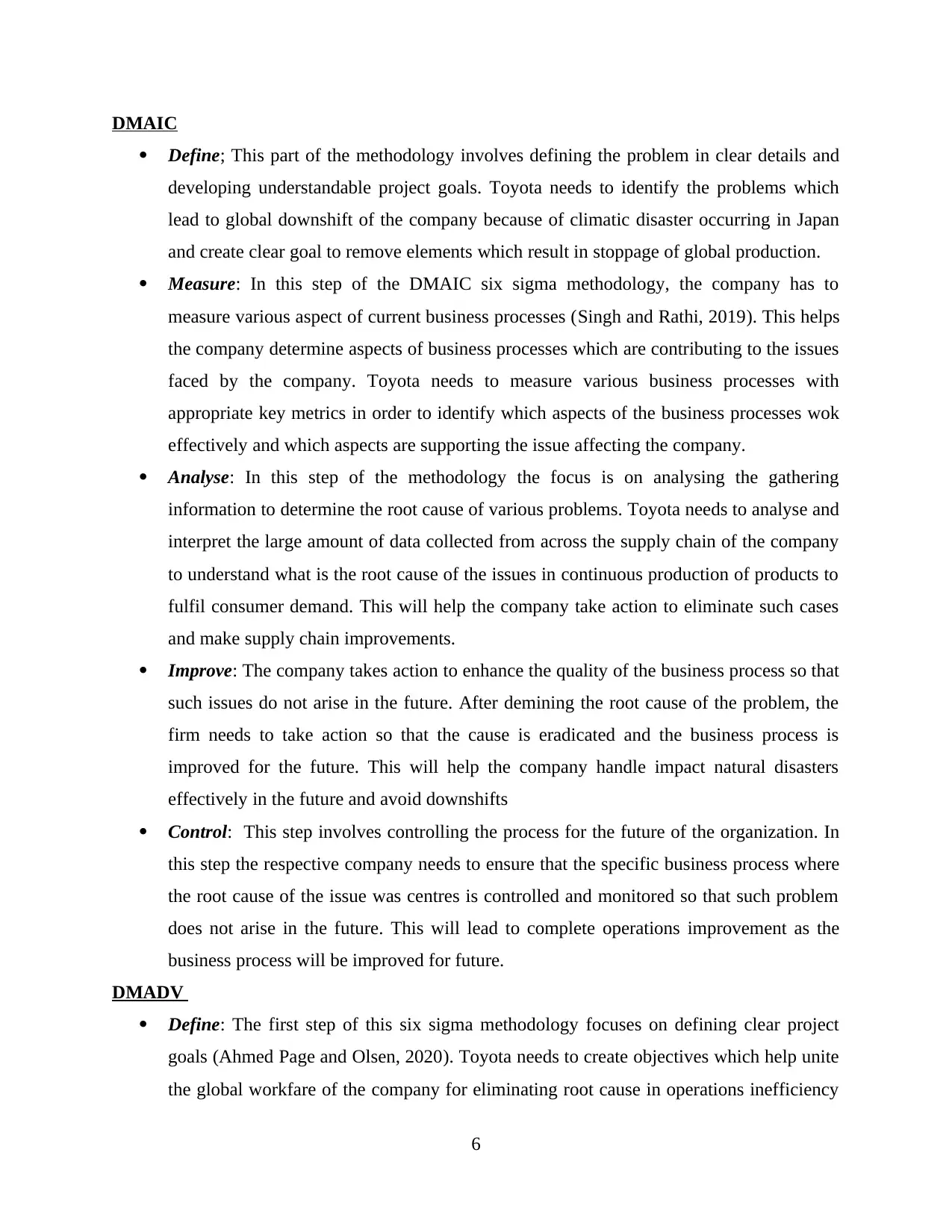
DMAIC
Define; This part of the methodology involves defining the problem in clear details and
developing understandable project goals. Toyota needs to identify the problems which
lead to global downshift of the company because of climatic disaster occurring in Japan
and create clear goal to remove elements which result in stoppage of global production.
Measure: In this step of the DMAIC six sigma methodology, the company has to
measure various aspect of current business processes (Singh and Rathi, 2019). This helps
the company determine aspects of business processes which are contributing to the issues
faced by the company. Toyota needs to measure various business processes with
appropriate key metrics in order to identify which aspects of the business processes wok
effectively and which aspects are supporting the issue affecting the company.
Analyse: In this step of the methodology the focus is on analysing the gathering
information to determine the root cause of various problems. Toyota needs to analyse and
interpret the large amount of data collected from across the supply chain of the company
to understand what is the root cause of the issues in continuous production of products to
fulfil consumer demand. This will help the company take action to eliminate such cases
and make supply chain improvements.
Improve: The company takes action to enhance the quality of the business process so that
such issues do not arise in the future. After demining the root cause of the problem, the
firm needs to take action so that the cause is eradicated and the business process is
improved for the future. This will help the company handle impact natural disasters
effectively in the future and avoid downshifts
Control: This step involves controlling the process for the future of the organization. In
this step the respective company needs to ensure that the specific business process where
the root cause of the issue was centres is controlled and monitored so that such problem
does not arise in the future. This will lead to complete operations improvement as the
business process will be improved for future.
DMADV
Define: The first step of this six sigma methodology focuses on defining clear project
goals (Ahmed Page and Olsen, 2020). Toyota needs to create objectives which help unite
the global workfare of the company for eliminating root cause in operations inefficiency
6
Define; This part of the methodology involves defining the problem in clear details and
developing understandable project goals. Toyota needs to identify the problems which
lead to global downshift of the company because of climatic disaster occurring in Japan
and create clear goal to remove elements which result in stoppage of global production.
Measure: In this step of the DMAIC six sigma methodology, the company has to
measure various aspect of current business processes (Singh and Rathi, 2019). This helps
the company determine aspects of business processes which are contributing to the issues
faced by the company. Toyota needs to measure various business processes with
appropriate key metrics in order to identify which aspects of the business processes wok
effectively and which aspects are supporting the issue affecting the company.
Analyse: In this step of the methodology the focus is on analysing the gathering
information to determine the root cause of various problems. Toyota needs to analyse and
interpret the large amount of data collected from across the supply chain of the company
to understand what is the root cause of the issues in continuous production of products to
fulfil consumer demand. This will help the company take action to eliminate such cases
and make supply chain improvements.
Improve: The company takes action to enhance the quality of the business process so that
such issues do not arise in the future. After demining the root cause of the problem, the
firm needs to take action so that the cause is eradicated and the business process is
improved for the future. This will help the company handle impact natural disasters
effectively in the future and avoid downshifts
Control: This step involves controlling the process for the future of the organization. In
this step the respective company needs to ensure that the specific business process where
the root cause of the issue was centres is controlled and monitored so that such problem
does not arise in the future. This will lead to complete operations improvement as the
business process will be improved for future.
DMADV
Define: The first step of this six sigma methodology focuses on defining clear project
goals (Ahmed Page and Olsen, 2020). Toyota needs to create objectives which help unite
the global workfare of the company for eliminating root cause in operations inefficiency
6
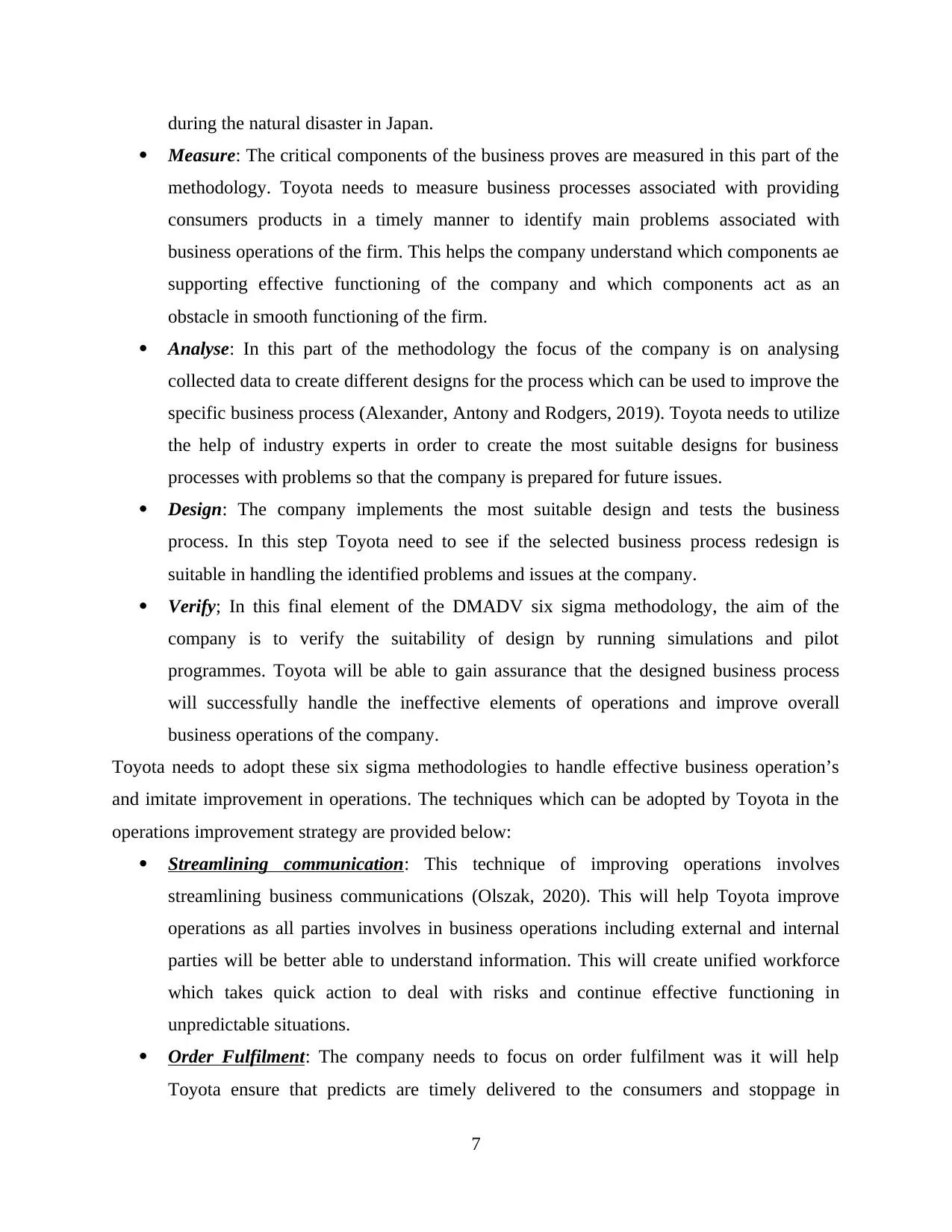
during the natural disaster in Japan.
Measure: The critical components of the business proves are measured in this part of the
methodology. Toyota needs to measure business processes associated with providing
consumers products in a timely manner to identify main problems associated with
business operations of the firm. This helps the company understand which components ae
supporting effective functioning of the company and which components act as an
obstacle in smooth functioning of the firm.
Analyse: In this part of the methodology the focus of the company is on analysing
collected data to create different designs for the process which can be used to improve the
specific business process (Alexander, Antony and Rodgers, 2019). Toyota needs to utilize
the help of industry experts in order to create the most suitable designs for business
processes with problems so that the company is prepared for future issues.
Design: The company implements the most suitable design and tests the business
process. In this step Toyota need to see if the selected business process redesign is
suitable in handling the identified problems and issues at the company.
Verify; In this final element of the DMADV six sigma methodology, the aim of the
company is to verify the suitability of design by running simulations and pilot
programmes. Toyota will be able to gain assurance that the designed business process
will successfully handle the ineffective elements of operations and improve overall
business operations of the company.
Toyota needs to adopt these six sigma methodologies to handle effective business operation’s
and imitate improvement in operations. The techniques which can be adopted by Toyota in the
operations improvement strategy are provided below:
Streamlining communication: This technique of improving operations involves
streamlining business communications (Olszak, 2020). This will help Toyota improve
operations as all parties involves in business operations including external and internal
parties will be better able to understand information. This will create unified workforce
which takes quick action to deal with risks and continue effective functioning in
unpredictable situations.
Order Fulfilment: The company needs to focus on order fulfilment was it will help
Toyota ensure that predicts are timely delivered to the consumers and stoppage in
7
Measure: The critical components of the business proves are measured in this part of the
methodology. Toyota needs to measure business processes associated with providing
consumers products in a timely manner to identify main problems associated with
business operations of the firm. This helps the company understand which components ae
supporting effective functioning of the company and which components act as an
obstacle in smooth functioning of the firm.
Analyse: In this part of the methodology the focus of the company is on analysing
collected data to create different designs for the process which can be used to improve the
specific business process (Alexander, Antony and Rodgers, 2019). Toyota needs to utilize
the help of industry experts in order to create the most suitable designs for business
processes with problems so that the company is prepared for future issues.
Design: The company implements the most suitable design and tests the business
process. In this step Toyota need to see if the selected business process redesign is
suitable in handling the identified problems and issues at the company.
Verify; In this final element of the DMADV six sigma methodology, the aim of the
company is to verify the suitability of design by running simulations and pilot
programmes. Toyota will be able to gain assurance that the designed business process
will successfully handle the ineffective elements of operations and improve overall
business operations of the company.
Toyota needs to adopt these six sigma methodologies to handle effective business operation’s
and imitate improvement in operations. The techniques which can be adopted by Toyota in the
operations improvement strategy are provided below:
Streamlining communication: This technique of improving operations involves
streamlining business communications (Olszak, 2020). This will help Toyota improve
operations as all parties involves in business operations including external and internal
parties will be better able to understand information. This will create unified workforce
which takes quick action to deal with risks and continue effective functioning in
unpredictable situations.
Order Fulfilment: The company needs to focus on order fulfilment was it will help
Toyota ensure that predicts are timely delivered to the consumers and stoppage in
7
⊘ This is a preview!⊘
Do you want full access?
Subscribe today to unlock all pages.

Trusted by 1+ million students worldwide
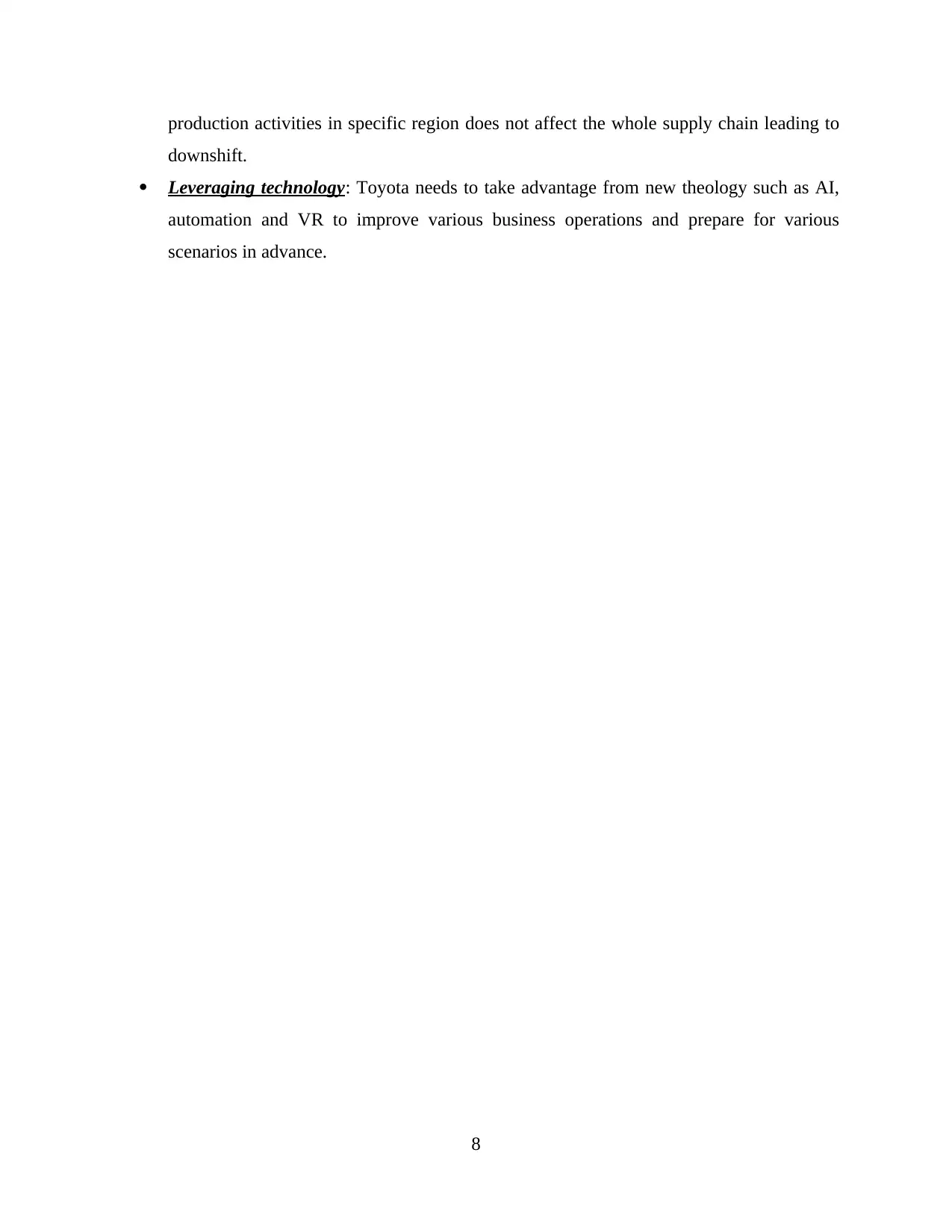
production activities in specific region does not affect the whole supply chain leading to
downshift.
Leveraging technology: Toyota needs to take advantage from new theology such as AI,
automation and VR to improve various business operations and prepare for various
scenarios in advance.
8
downshift.
Leveraging technology: Toyota needs to take advantage from new theology such as AI,
automation and VR to improve various business operations and prepare for various
scenarios in advance.
8
Paraphrase This Document
Need a fresh take? Get an instant paraphrase of this document with our AI Paraphraser
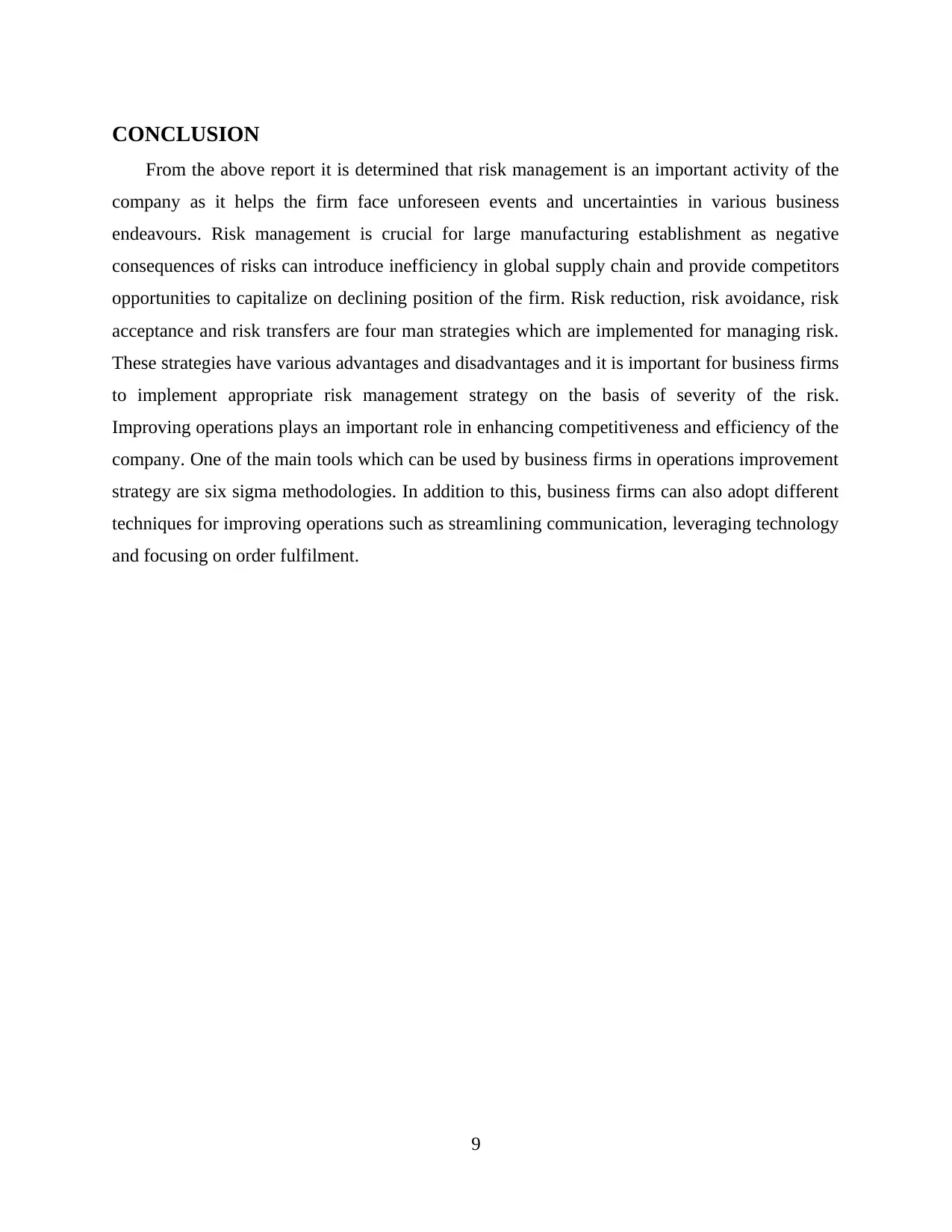
CONCLUSION
From the above report it is determined that risk management is an important activity of the
company as it helps the firm face unforeseen events and uncertainties in various business
endeavours. Risk management is crucial for large manufacturing establishment as negative
consequences of risks can introduce inefficiency in global supply chain and provide competitors
opportunities to capitalize on declining position of the firm. Risk reduction, risk avoidance, risk
acceptance and risk transfers are four man strategies which are implemented for managing risk.
These strategies have various advantages and disadvantages and it is important for business firms
to implement appropriate risk management strategy on the basis of severity of the risk.
Improving operations plays an important role in enhancing competitiveness and efficiency of the
company. One of the main tools which can be used by business firms in operations improvement
strategy are six sigma methodologies. In addition to this, business firms can also adopt different
techniques for improving operations such as streamlining communication, leveraging technology
and focusing on order fulfilment.
9
From the above report it is determined that risk management is an important activity of the
company as it helps the firm face unforeseen events and uncertainties in various business
endeavours. Risk management is crucial for large manufacturing establishment as negative
consequences of risks can introduce inefficiency in global supply chain and provide competitors
opportunities to capitalize on declining position of the firm. Risk reduction, risk avoidance, risk
acceptance and risk transfers are four man strategies which are implemented for managing risk.
These strategies have various advantages and disadvantages and it is important for business firms
to implement appropriate risk management strategy on the basis of severity of the risk.
Improving operations plays an important role in enhancing competitiveness and efficiency of the
company. One of the main tools which can be used by business firms in operations improvement
strategy are six sigma methodologies. In addition to this, business firms can also adopt different
techniques for improving operations such as streamlining communication, leveraging technology
and focusing on order fulfilment.
9
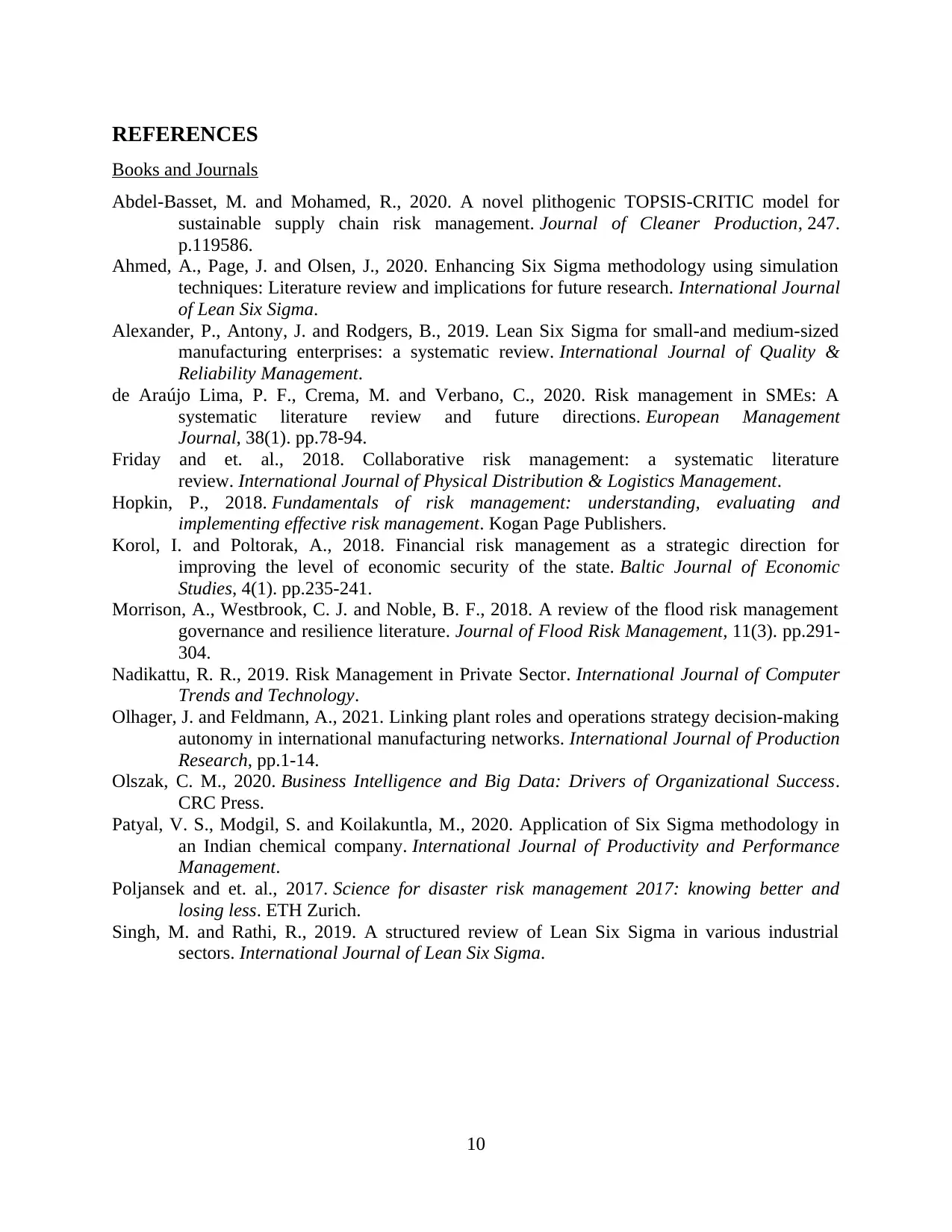
REFERENCES
Books and Journals
Abdel-Basset, M. and Mohamed, R., 2020. A novel plithogenic TOPSIS-CRITIC model for
sustainable supply chain risk management. Journal of Cleaner Production, 247.
p.119586.
Ahmed, A., Page, J. and Olsen, J., 2020. Enhancing Six Sigma methodology using simulation
techniques: Literature review and implications for future research. International Journal
of Lean Six Sigma.
Alexander, P., Antony, J. and Rodgers, B., 2019. Lean Six Sigma for small-and medium-sized
manufacturing enterprises: a systematic review. International Journal of Quality &
Reliability Management.
de Araújo Lima, P. F., Crema, M. and Verbano, C., 2020. Risk management in SMEs: A
systematic literature review and future directions. European Management
Journal, 38(1). pp.78-94.
Friday and et. al., 2018. Collaborative risk management: a systematic literature
review. International Journal of Physical Distribution & Logistics Management.
Hopkin, P., 2018. Fundamentals of risk management: understanding, evaluating and
implementing effective risk management. Kogan Page Publishers.
Korol, I. and Poltorak, A., 2018. Financial risk management as a strategic direction for
improving the level of economic security of the state. Baltic Journal of Economic
Studies, 4(1). pp.235-241.
Morrison, A., Westbrook, C. J. and Noble, B. F., 2018. A review of the flood risk management
governance and resilience literature. Journal of Flood Risk Management, 11(3). pp.291-
304.
Nadikattu, R. R., 2019. Risk Management in Private Sector. International Journal of Computer
Trends and Technology.
Olhager, J. and Feldmann, A., 2021. Linking plant roles and operations strategy decision-making
autonomy in international manufacturing networks. International Journal of Production
Research, pp.1-14.
Olszak, C. M., 2020. Business Intelligence and Big Data: Drivers of Organizational Success.
CRC Press.
Patyal, V. S., Modgil, S. and Koilakuntla, M., 2020. Application of Six Sigma methodology in
an Indian chemical company. International Journal of Productivity and Performance
Management.
Poljansek and et. al., 2017. Science for disaster risk management 2017: knowing better and
losing less. ETH Zurich.
Singh, M. and Rathi, R., 2019. A structured review of Lean Six Sigma in various industrial
sectors. International Journal of Lean Six Sigma.
10
Books and Journals
Abdel-Basset, M. and Mohamed, R., 2020. A novel plithogenic TOPSIS-CRITIC model for
sustainable supply chain risk management. Journal of Cleaner Production, 247.
p.119586.
Ahmed, A., Page, J. and Olsen, J., 2020. Enhancing Six Sigma methodology using simulation
techniques: Literature review and implications for future research. International Journal
of Lean Six Sigma.
Alexander, P., Antony, J. and Rodgers, B., 2019. Lean Six Sigma for small-and medium-sized
manufacturing enterprises: a systematic review. International Journal of Quality &
Reliability Management.
de Araújo Lima, P. F., Crema, M. and Verbano, C., 2020. Risk management in SMEs: A
systematic literature review and future directions. European Management
Journal, 38(1). pp.78-94.
Friday and et. al., 2018. Collaborative risk management: a systematic literature
review. International Journal of Physical Distribution & Logistics Management.
Hopkin, P., 2018. Fundamentals of risk management: understanding, evaluating and
implementing effective risk management. Kogan Page Publishers.
Korol, I. and Poltorak, A., 2018. Financial risk management as a strategic direction for
improving the level of economic security of the state. Baltic Journal of Economic
Studies, 4(1). pp.235-241.
Morrison, A., Westbrook, C. J. and Noble, B. F., 2018. A review of the flood risk management
governance and resilience literature. Journal of Flood Risk Management, 11(3). pp.291-
304.
Nadikattu, R. R., 2019. Risk Management in Private Sector. International Journal of Computer
Trends and Technology.
Olhager, J. and Feldmann, A., 2021. Linking plant roles and operations strategy decision-making
autonomy in international manufacturing networks. International Journal of Production
Research, pp.1-14.
Olszak, C. M., 2020. Business Intelligence and Big Data: Drivers of Organizational Success.
CRC Press.
Patyal, V. S., Modgil, S. and Koilakuntla, M., 2020. Application of Six Sigma methodology in
an Indian chemical company. International Journal of Productivity and Performance
Management.
Poljansek and et. al., 2017. Science for disaster risk management 2017: knowing better and
losing less. ETH Zurich.
Singh, M. and Rathi, R., 2019. A structured review of Lean Six Sigma in various industrial
sectors. International Journal of Lean Six Sigma.
10
⊘ This is a preview!⊘
Do you want full access?
Subscribe today to unlock all pages.

Trusted by 1+ million students worldwide
1 out of 12
Related Documents
Your All-in-One AI-Powered Toolkit for Academic Success.
+13062052269
info@desklib.com
Available 24*7 on WhatsApp / Email
![[object Object]](/_next/static/media/star-bottom.7253800d.svg)
Unlock your academic potential
Copyright © 2020–2025 A2Z Services. All Rights Reserved. Developed and managed by ZUCOL.




